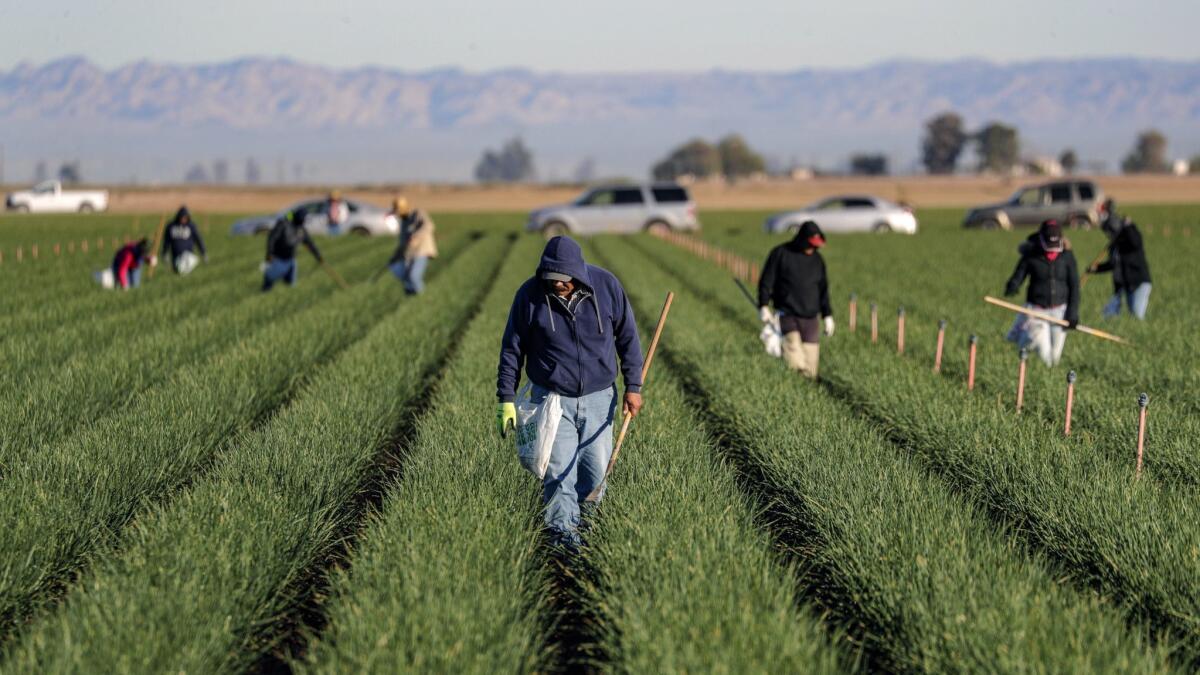Op-Ed: California is making a weak effort to turn agriculture into a climate change fix

Agriculture generates 9% of California’s greenhouse gas emissions, which makes it the state’s fourth-largest emitter, after transportation, industry and buildings. But agriculture — often seen as an enemy of the environment — is the only one of these sectors with the potential to also remove carbon dioxide from the atmosphere.
Healthy soil teems with life — more than a billion microorganisms per teaspoon — along with, crucially, carbon. Unfortunately, tilled soil releases a lot of that carbon, which combines with oxygen to add CO2 to the atmosphere. What’s called regenerative or carbon-focused farming — composting, minimizing tillage, using cover crops and crop rotation, planting hedgerows and windbreaks to foster biodiversity and cut down on blowing soil, and retaining crop residue on farmland — can slow the carbon loss and even pull it, through photosynthesis, from the atmosphere into vegetation and soil. That “draw down” capacity is a crucial tool in the struggle to limit climate change, and, for California, in its attempt to meet its goal of carbon neutrality by 2045.
Science shows that carbon-focused farming can also improve crop yields and livestock health, increase crop resilience to drought, reduce erosion and flooding, improve soil water-holding capacity and allow farmers to cut back on the use of synthetic fertilizers. Over time, these practices can lower costs for farmers, and by building resilience in crops, they may also reduce federal crop insurance payouts, saving taxpayers money.
Even buttressed with a solid knowledge base, a farm’s successful transition to carbon-focused practices can take several years.
Rattan Lal, an Ohio State University soil scientist, calls regenerative agriculture a “win-win-win option.” But, he says, its advantages are “not widely understood by policymakers and the general public” — and even most farmers.
One indication of the general incomprehension is the tepid support that California officials have given to regenerative farming. The state began providing grants to farmers and researchers for implementing and demonstrating carbon-focused practices in 2017. The budget for the Healthy Soils Program was just $7.5 million. That same year, California spent $165 million on electric car rebates.
The soils program also obligated farmers to fill out maddeningly complex grant applications, not something required to collect a car rebate. CalCAN, the nonprofit California Climate and Agriculture Network, reported on the outcome: Nearly 400 farmers and ranchers attended government- and nonprofit-sponsored workshops designed to explain how Healthy Soils would work, and 175 started the application process. But only 96 completed it, largely because of the application’s complexity and the time needed to fill it out.
In January, state agencies outlined two scenarios of varying degrees of ambition to increase carbon-focused farming in California. The more ambitious, but still modest, plan envisioned engaging 1 million acres of farmland — roughly 4% of the state’s agricultural acreage — by 2030, at a cost of $36.3 million a year. Add to that money for demonstration projects and technical assistance, and CalCAN calculates a total investment of around $50 million a year. Yet Gov. Gavin Newsom, who has referred to healthy soils as an “interesting passion of mine,” is budgeting just $28 million for the effort.
As Jeff Creque, agricultural director at the Carbon Cycle Institute, which promotes carbon-focused agriculture, told me, the state should instead be aiming to engage 3% of its agricultural land annually, so that by 2050 all of the state’s 25 million acres of agricultural land becomes a net carbon sink — that’s the kind of commitment needed to meet the state’s decarbonization goals.
Enter the Fray: First takes on the news of the minute »
This kind of agricultural transformation won’t be simple. For starters, most farmers aren’t swayed by emphasis on climate benefits. They need to know that the transition won’t bankrupt them, and that it could ultimately lead to higher profits or other farmland benefits. And while the principles of carbon-focused agriculture are settled science, implementing them in California requires more research and experimentation. Even buttressed with a solid knowledge base, a farm’s successful transition to carbon-focused practices can take several years.
The state should be going all out to fund and support research and outreach, and to provide technical support for farmers willing to make the shift.
“Over and over again, as producers become familiar with carbon farming,” Creque said, “we’ve watched the light bulbs go on in their heads as they begin to understand the benefits to their agricultural operations.”
Anthropogenic climate change isn’t just a fossil fuel problem. Ancient farmers took the first steps towards the current climate crisis simply by tilling soil, releasing carbon into the atmosphere. Some 12,000 years later, it’s both urgent and appropriate for farmers to get a chance to put it back.
Jacques Leslie is a contributing writer to Opinion.
Follow the Opinion section on Twitter @latimesopinionand Facebook
More to Read
A cure for the common opinion
Get thought-provoking perspectives with our weekly newsletter.
You may occasionally receive promotional content from the Los Angeles Times.






